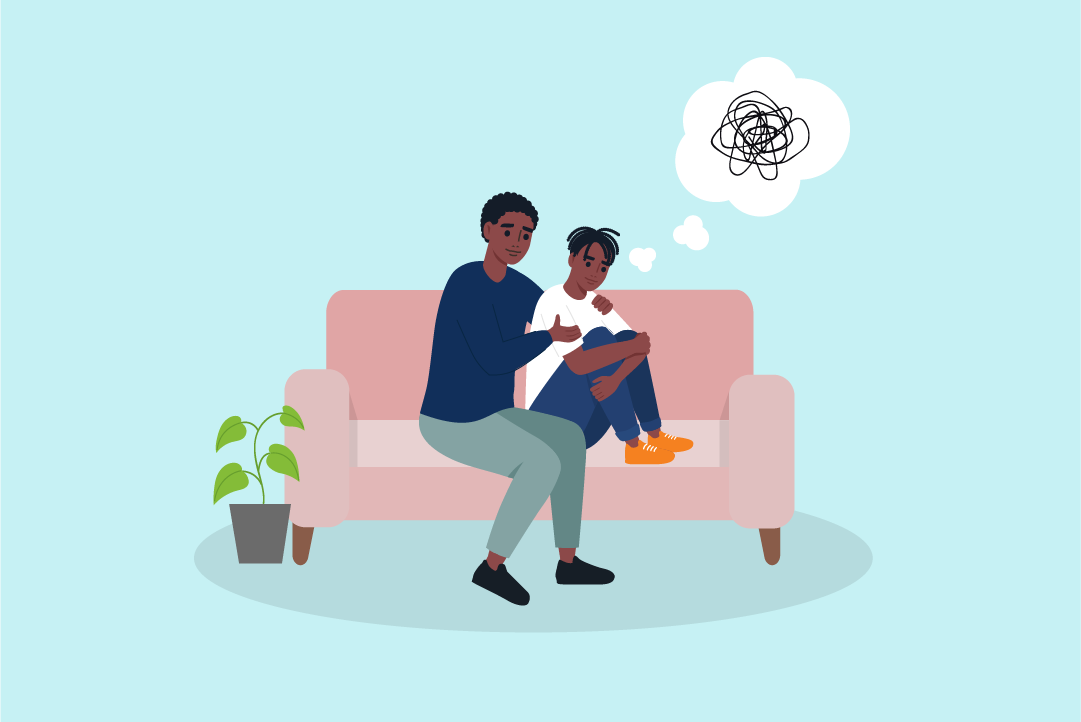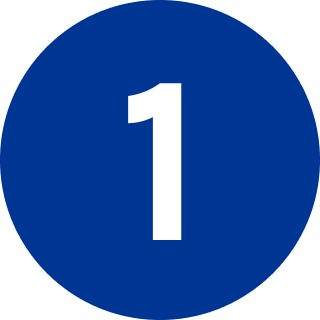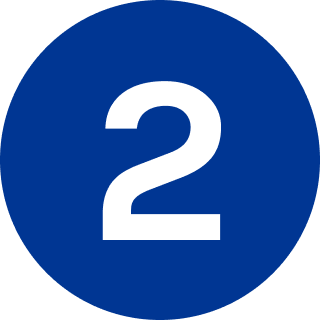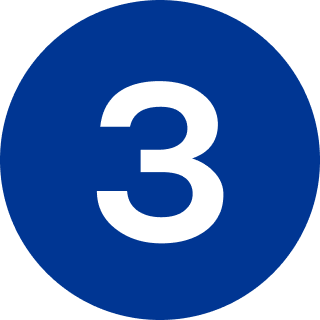GET HELP
MAY 2024
Managing anxiety for kids and teens
Has your child frequently complained about feeling sick to their stomach? Does your teen seem increasingly irritable or withdrawn? Have your kids stopped doing the things they used to enjoy? These may be signs of anxiety.
Anxiety disorders are the most common childhood mental health condition, affecting 1 in 8 children.1 They are also highly treatable with the right care. Read on for information about childhood anxiety and how you can help your child build skills and resilience to manage their symptoms.
Looking for more? Find other articles below

Forms of anxiety
Anxiety is a normal human response to stress, danger or a threat. But if the anxiety persists once the threat is gone or the threat never existed in the first place, it can get in the way of your child being able to live their life. This may indicate that they need help.
Anxiety can show up for kids in a lot of different scenarios, including:
- Separating from primary caregivers
- Social situations that can bring up fears of not fitting in or being judged or bullied
- Worry about grades or doing well enough
- Fear of failure or the unknown
- Irrational, unspecified or obsessive fear
- Worry about germs or contamination
It’s common for kids to feel anxiety on multiple fronts, such as feeling anxious about attending a class for both social and academic reasons.
Signs of anxiety
Since anxiety disorders tend to run in families, they are most likely caused by a combination of genetics and environment. Here are some signs of anxiety that occur within:
Any
age
Trouble sleeping
Low appetite
Excessive worrying or negative thoughts
Irritability
Constantly looking for reassurance
Younger children
Headaches or stomachaches
Having accidents at night
Returning to behaviors that they had outgrown (regression)
Acting out
Frequent crying
Being clingy or fidgety
Touching crotch area (more common in boys)
School-age children, teens and tweens
Avoiding school and other social settings
Trouble concentrating
Withdrawing from family and friends
Not keeping up with personal hygiene
Angry outbursts
Physical symptoms: headaches, stomachaches, racing heart, muscle tension, missed periods, sweating or blushing
Short videos from Brightline are available to help parents understand childhood anxiety. Watch this video for a deeper dive into the symptoms of anxiety and this video to learn more about anxiety in younger kids.
Anxiety and other mental health conditions
Childhood anxiety often occurs along with a range of mental health conditions, including developmental differences and learning challenges. Here are some that are most common.
Anxiety and panic attacks
A panic attack is a period of intense fear and anxiety that can last minutes or hours. It may be triggered by something stressful, though many are unexpected. Panic attacks most often start in the tween or teen years and can become so severe that the child may be afraid to leave home. Symptoms can include a racing heartbeat, tightness in the chest, lightheadedness, stomach cramps, shaking legs, and fears of losing control or dying.
Anxiety and depression
Depression and anxiety disorders commonly occur together in children, even sharing some symptoms such as trouble sleeping, increased irritability, and withdrawing from friends or activities. In fact, kids who have anxiety as children are more likely to have depression as teens.
Anxiety and ADHD
About 3 in 10 children with attention-deficit/hyperactivity disorder (ADHD) also have an anxiety disorder.2 These conditions can look very much alike in certain circumstances. Some of the symptoms of ADHD can be the same as the symptoms of anxiety. If your child is struggling, a counselor or therapist can determine how best to support your child.
What you can do
If you’re a parent or caregiver, your child’s health and well-being couldn’t be more important. Following these steps when your child’s anxiety is interfering with their normal activities can be life changing for your child and your family.

Have calm, open conversations.
Approach conversations when your child is anxious with empathy, compassion and honesty. It’s important to be patient as you help your child navigate solutions. Try to:
- Validate their feelings. Let them know it’s okay to feel stressed out, worried or afraid.
- Model coping. Talk them through your own experiences with anxiety. For example, if talking to a neighbor made you feel anxious, let your kids know how you feel and how you’re planning to cope, maybe by drinking a glass of water and taking a walk around the block.
- Avoid blanket reassurances. Saying “that’s not going to happen” isn’t necessarily true. Instead, let your child know you have confidence that they can handle what they fear.
- Show your kids that they’re not their anxiety. Dr. Kendra Read, VP of Therapy at Brightline, suggests one way to do this is to encourage your kids to give their anxiety a name — anything from Bob to Voldemort. This may help them see that they aren’t controlled by this one emotion.

Help them face their fears.
If kids have anxiety about something, they tend to avoid it. That’s true even for adults, who may find it hard to do tasks that are intimidating or overwhelming. Avoiding a task can keep kids safe in the moment, but it also reinforces the idea that they can’t do it, or they can’t tolerate their anxiety.
While it’s natural to want to swoop in and rescue your child when they’re in distress, making a plan to approach the things that they’re afraid of will be beneficial in the long run. Over time, their anxiety will be lowered because their new learning will make them more resilient. It will reinforce the fact that they can do hard things.

Seek professional help.
One of the best ways to treat anxiety is with counseling. Your Costco benefits offer several resources to help you help your child.
- Brightline* can provide quick access to therapists and medication management for children ages 6–18 if you’re enrolled in an Aetna® medical plan. Worry and anxiety are the top reasons Costco employees pursue therapy with their child through Brightline. Free educational resources and health coaching are also available for families with children ages 0–18.
- AbleTo** helps adults and children age 13+ build skills to manage anxiety, depression and stress through eight-week virtual therapy and well-being programs personalized to your needs and challenges.
- Talkspace, a program from Resources for Living, is an on-demand video chat- and text-based therapy program, available 24/7 to teens age 13+ and adults. The first six sessions are free to all Costco employees, their household members and dependent children up to age 26.
*Available only on the mainland.
**Not available in Puerto Rico.
1National Library of Medicine. Anxiety in children.
2ADDitude. Which came first: the anxiety or the ADHD?
Sources:
Brightline. Webinar: Identifying & addressing anxiety for youth.
WebMD. Recognizing childhood depression and anxiety.
American Academy of Child & Adolescent Psychiatry. Panic disorder in children and adolescents.
Check out the resources below to get the support your family needs — much of it at no cost to you.
Resources for you
- Brightline offers parents and their dependents up to age 18 who are covered by an Aetna® medical plan access to behavioral health coaches, videos, webinars and other digital tools to help with anxiety, depression, stress, sleep concerns and more. Therapy and medication management are available to children ages 6–18. Visit HelloBrightline.com/Costco or call 888-224-7332 to learn more.
- AbleTo helps you and your family enrolled in a Costco medical plan learn to manage depression, anxiety and stress, as well as tools and content to help you build mental wellness. Visit AbleTo.com/Costco or call 833-881-1444.
- Talkspace, a program provided by Resources for Living, offers 24/7 individual, couples, teen and other types of therapy through text or video chat, 24/7. Conditions treated include anxiety, depression, panic disorder, PTSD and more for teens age 13+ and adults. The first six sessions are free to you, your household members and dependent children up to age 26. Learn more at RFL.com/Costco or call 833-721-2320 (TTY: 711).
- Suicide & Crisis Lifeline is the resource to turn to if your child or someone you know is in crisis. Call or text 988 to get immediate help.
- Talkspace, a program provided by Resources for Living, offers 24/7 individual, couples, teen, and other types of therapy through text or video chat, 24/7. Conditions treated include anxiety, depression, panic disorder, PTSD and more for teens age 13+ and adults. The first six sessions are free to you, your household members and dependent children up to age 26. Learn more at RFL.com/Costco or call 833-721-2320 (TTY: 711).
- Mind Companion Self-care offers digital emotional support sessions on anxiety, depression, stress and more that you can do at your own pace. This free program is available to you, your household (13+) and dependent children up to age 26. Visit RFL.com/Costco or call 833-721-2320 (TTY: 711) to learn more.
- Suicide & Crisis Lifeline is the resource to turn to if your child or someone you know is in crisis. Call or text 988 to get immediate help.
- AbleTo helps you and your family enrolled in a Costco medical plan learn to manage depression, anxiety and stress, as well as tools and content to help you build mental wellness. Visit AbleTo.com/Costco or call 833-881-1444.
- Talkspace, a program provided by Resources for Living, offers 24/7 individual, couples, teen and other types of therapy through text or video chat, 24/7. Conditions treated include anxiety, depression, panic disorder, PTSD and more for teens age 13+ and adults. The first six sessions are free to you, your household members and dependent children up to age 26. Learn more at RFL.com/Costco or call 833-721-2320 (TTY: 711).
- Mind Companion Self-care offers digital emotional support sessions on anxiety, depression, stress and more that you can do at your own pace. This free program is available to you, your household (13+) and dependent children up to age 26. Visit RFL.com/Costco or call 833-721-2320 (TTY: 711) to learn more.
- Suicide & Crisis Lifeline is the resource to turn to if your child or someone you know is in crisis. Call or text 988 to get immediate help.

